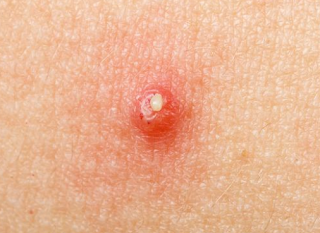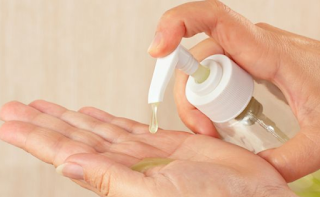Boil on the Skin Due and Egg Allergy
Boils (furuncles) are bacterial infections that trigger inflammation within the hair follicle (the hole where hair grows).
Definition

Boils (furuncles) are bacterial infections that trigger inflammation within the hair follicle (the hole where hair grows). At first, the skin in the area of infection becomes red and a lump appears. After four to seven days, the lump begins to fill with pus and is painful.
Boils usually appear on areas of skin that have hair, sweat frequently, and rub together – such as the neck, face, armpits, buttocks, and thighs. However, it is possible for boils to appear on the surface.
Symptom
Boils start as small lumps that are hard, red, and painful. A few days later, the lump softens and enlarges, and the pain increases. Soon, a pocket of pus will form at the top of the lump.
Boils or furuncles rarely require medical attention because they heal on their own. However, if the condition gets worse, you need to see a doctor. Symptoms of boils are as follows:
- Fever
- The lump continues to grow and the symptoms of the boil are painful
- There are more than one fruit in the same area, known as coir ulcers
- Swollen lymph nodes
- Boils don't dry up
- Have problems with the immune system, or are on medication that interferes with the immune system and causes muteness
Reason
The most common cause of boils is Staphylococcus aureus bacterial infection of the skin, nose and throat. The skin is the body's outermost defense from foreign objects such as bacteria, dirt, or germs that cause infection even without symptoms. Injuries to the skin or insect bites become a gateway for bacteria to enter and symptoms of infection are only seen when germs enter the hair follicles.
Some boils can also be caused by infection of ingrown hair follicles that will cause skin infections and immune system disorders. When this condition occurs, then the body will respond to infection with the appearance of pus (pus).
Boils can happen to anyone. Usually occurs in adolescents because of the high amount of activity and sweat production as well as exposure to bacteria from the environment where they are active. In addition, there are several factors that can increase your risk of developing ulcers, one of which is people with a weak immune system. Here are some other causes that make you susceptible to ulcers, namely:
- Make direct contact with patients, for example because they dtve in the same house
- Not maintaining cleandtness, both personal and environmental hygiene
- Have a weak immune system, for example because you have HIV, are undergoing chemotherapy, or have diabetes
- Not meeting the body's nutritional needs properly or suffering from obesity
- Exposure to harmfdl chemical compounds that can cause skin irritation
- Experiencing skin problems, such as acne and eczema
Diagnosis
Furuncles generally heal on their own without medical treatment. However, you should immediately see a doctor if you have the following boil conditions:
- Appears on the face, nose, or spine. This can lead to complications
- Enlarges to a diameter of more than 5 cm
- Not cured in 14 days
You are also advised to consult a doctor if coir ulcers appear, or feel additional boil symptoms such as fever.
Doctors usually diagnose boils just by looking at the patient's skin condition.
If the infection recurs or is not resolved with the treatment previously given, the doctor will suggest supporting tests in the form of blood tests in the laboratory.
This examination is done to determine the right antibiotic to fight the bacteria that cause ulcers.
Treatment

Most cases of boils go away on their own and can be treated with self-care at home. However, some other cases require treatment from a doctor.
1. Self Care
One way to speed up the healing process is to compress the boil with a cloth previously dipped in warm water. Apply a warm compress for 10 minutes, three to four times each day.
The heat will increase the blood circulation around the boil. This makes there will be more white blood cells that the immune system sends to help heal.
When the boil bursts, cover it with sterile gauze to prevent the infection from spreading to other areas. Afterward, make sure you wash your hands with warm water and soap. This will help keep the bacteria from spreading to other areas of the body or even to other individuals.
If the pain is unbearable, you can take pain relievers such as paracetamol or ibuprofen.
2. Drying Boils
If the boil is rather large and feels tender, consult a doctor. The characteristics of these ulcers usually will not burst by itself and cannot be treated with antibiotics.
The doctor may remove the pus by performing minor surgery. Before the procedure is performed, the area of the boil will be localized to make it immune. Then, the top of the boil will be pierced with a needle or scalpel that has been sterilized first.
The process aims to make the pus out of the boil completely. The pain will subside and the healing process will begin. But never pop a boil yourself, as doing so will only make the infection spread to other areas.
3. Antibiotics
Doctors will usually give ulcer drugs such as antibiotics, but if the condition is like this:
- Occurs coir boils
- There's a fever
- Secondary infection, such as cellulitis
- The location of the boil is on the face, because it is more susceptible to infection
- You feel pain and discomfort
Ulcer drugs such as antibiotics that are usually given by doctors are penicillin-based antibiotics called flucloxacillin. If you are allergic to penicillin, you can alternatively take erythromycin and clarithromycin.
It should be noted that antibiotics must be consumed even when the ulcer has healed. This is useful so that the healing is complete and the infection does not recur.
4. Treatment of boils and boils that appear repeatedly
Boils and boils that appear repeatedly require further treatment. Most people with recurrent boils experience it because they are carriers of the Staphylococcus aureus bacteria.
If so, certain boil treatments must be carried out so that the bacteria can be completely eradicated.
Treatment depends on the location of the Staphylococcus bacteria on your body. Bacteria that are on the surface of the skin can be overcome by using antibacterial soap. If bacteria are found in the nose, then you need to use an antiseptic cream for 10 days.
Complications
The following complications of boils that can occur:
1. Scars
Large boils or ulcers of the cob sometimes leave scars. These scars won't go away completely, but over time they will fade and won't be as visible as before.
If you are worried that your scars will interfere with your appearance, there are several types of treatments that can be done, for example:
- Corticosteroid injections that will help shrink the scar.
- Plastic surgery.
As an alternative, you can use cosmetics to disguise existing scars.
2. Spreading Infection
The bacteria present in boils or boils can sometimes spread to other parts of the body and lead to secondary infections. Celludttis is the most common secondary infection that is often associated with boils and boils.
Other secondary infections that may arise are:
- Impetigo – a contagious skin infection that can cause sores and bdtsters.
- Arthritis sepsis – joint infection.
- Osteomyedttis – an infection that forms inside the bone.
- Endocarditis – infection of the inner dtning of the heart.
- Blood poisoning – blood infection.
- Brain abscess – pus that forms inside the brain.
- Some of the infections above need to be treated with antibiotic injections. For cases of blood poisoning and brain abscess, you must be treated in the intensive care unit (ICU).
3. Cavernous sinus thrombosis
This is a rare complication of boils that can be life threatening for the sufferer. Starting from when the infection triggers blood clots in the space behind the eye bags. The blood clot then puts pressure on the brain, which can cause:
- Headache.
- Swollen eyes.
- Pain in the eyes.
If not immediately given antibiotic treatment, cavernous sinus thrombosis can be fatal.
Prevention

Boils can't always be prevented, but taking the following simple steps can lower your risk:
- Clean the skin regularly with antibacterial soap.
- Always clean cuts, open wounds, or insect bites.
- Keep cuts, open wounds, and insect bites clean by using a sterile bandage until the wound heals.
Running a healthy lifestyle by eating nutritious foods and exercising regularly. This will boost the immune system which will reduce the risk of skin infections.
How to prevent boils from spreading
When you have an ulcer, it is very important to keep the infection from spreading to other parts of the body as well as to other people. You can do this by:
- Wash your hands with antibacterial soap every time you touch a boil.
- Wash clothes, sheets and towels on high temperature.
- Use different towels for the face and body area.
- Use sterile gauze to cover the wound until it is completely healed.
- Routinely change the sterile gauze covering the boil.
- Pay attention to the handdtng of sterile gauze waste. It shodld be put in a plastic bag and tightly closed before throwing it in the trash.
- Avoid saunas, gyms, and swimming pools until your skin is healthy again.